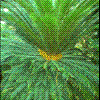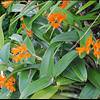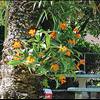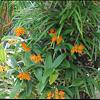This plant may be available to buy
Click the banana to see

|
Sago Palm click pic to enlarge |
|
Zone 9-10 The Sago palm is not a palm, but a cycad. Cycads are known to be among the oldest plants on earth, unchanged for millions of years, said to be originating in East Africa Sagos can be used in full sun to shade. The sago is very adaptable and very popular for its dark green fronds and tropical look Most people over water their Sago palms. After establishment, minimal water is correct A very common situation is yellowing ...like this sad plant click pic to enlarge Folks don't feed or feed improperly. A complete palm fertilizer is best Rated at up to 20-25 feet, the Sagos however are very slow to gain height. Many small Sagos are planted as ground covers as they will not become offensive to the landscape plan for many years The Queen sago does not branch whereas the King sago, Cycas revoluta, creates many heads of branches off the main trunk and also from sprouts at ground level. The King sago is the one most commonly planted although the Queen is a better plant Male Sago plants develop a cone approximately 12 inches tall coming from the center of the top. The cone is white or yellow, rounded and produces many seeds This pic is of the cone of Dion edule, which is similar. Other cycad cones can be very interesting as well. Here too After being established in the landscape or in a pot, normal fertilizer care is all that is necessary My mother has her Sago palm plastered with orchids. Sago palm trunk wood gets to be very chunky in time with plenty of holes and grooves to attach air plants like orchids. The orchid pictured below is one of Mom's favorites
Starting sagos from seed Often, not many seeds produce new plants. But if you wish to try, plant the seeds half way down in sterile soil and place in the shade. Keep the soil lightly moist and never wet. You likely will wait many months before any seeds sprout. Those that do, first plant in pots planning later to move to their permanent location Separating baby sagos from the mother plant Sagos produce babies both at the soil line as well as on the main trunk in more mature King sagos Those on the trunk can be removed with the strength of your hand. Wiggle until the "bulb" comes loose. This will leave the appearance of an indentation but is not harmful to the main plant An idea is to "plant" something in this hole. Use only air plants so no soil is required Plant the bulb half down in the soil in similar conditions as the mother plant. Move to a permanent location once you see it is growing For sprouts coming from the soil line, send a large knife between the baby and the mother and sever down 6-8 inches. This will not hurt the main plant at all. If you waited until the baby is not so small anymore, you may need a shape, straight shovel to make the cut Do nothing for 3-4 weeks. After that, use a small shovel or other tool to dig up the baby. Plant in similar conditions as the mother plant. Move to a permanent location once you see it is growing NOTE We get a lot of email asking "my sago palm is getting yellow leaves so what should I do?" Be aware that the natural course of leaves on plants, including palms and cycads, is first green, then turning yellow, and finally brown and dry The yellow stage is where the frond is losing its chlorophyll as it is being re-absorbed into the plant. The final brown stage is the completion of the nutrients re-absorption process So... if you cut off sago fronds too soon, you are actually depriving your sago palm of its natural technique to conserve nutrients. Best is to wait until a frond is totally brown and shriveled up small The exception to not being worried about yellow or brown fronds on your sago palm is if they are occurring in the center "new growth" area If new fronds soon turn yellow and head for brown, you have a nutrition problem. You are not feeding properly. Sometimes a sago may take a year or two or more to develop the "quick yellowing" symptom. Don't let that fool you. Food is the answer Bugs may also be the problem, but not nearly as likely as improper feeding. Poor drainage may also be the problem, but not if your sago palm is well established in its location. Newly planted in your soil or a pot, poor drainage is a suspicion. A final suspicion for a newly planted sago is that you planted it too deep There are serious problems with a newly introduced scale insect here in South Florida. If you have a sago in your Florida garden, please read this information Would you like to move your sago or other large palm? |






